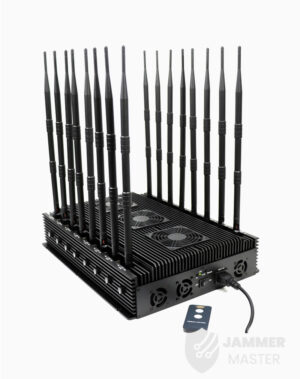
Buying Guide for Portable Signal Jammers
Key Takeaways Consideration Detail Product Weight Jammer Master’s portable jammers average 1.5Kg, significantly lighter than desktop models. Frequency Bands Capable of blocking multiple bands with
Free Worldwide Shipping & 1-Year Warranty!

Wireless interference devices are commonly used in examination halls to maintain a controlled testing environment. However, these devices often go unnoticed due to their inconspicuous appearance, leaving many people unaware of their purpose and functionality. This article aims to shed light on the features and benefits of wireless interference devices, dispelling any confusion surrounding their usage.

Handheld Multi-Purpose Signal Blocker Jam 5G/WiFi/GPS/LOJACK/RC JM016
$899.00
Desktop 5G Cellular Signal Jammer Block Cellular/Wireless/GPS/LoJack JM006
$1,839.99
Suitcase Style Signal Jammer Block Cellular/WiFi/GPS JM007
$2,659.99
16 Antennas Signal Jammer Block Multiple Frequencies JM002
$1,088.99One of the distinguishing features of wireless interference devices is their concealed antenna. Unlike traditional visible antennas, these devices are designed with an internal antenna to prevent tampering or damage. While some individuals may be perplexed by the absence of an antenna, it is important to note that the antenna is indeed present, albeit hidden within the device.
To ensure minimal disruption to exam candidates, wireless interference devices are equipped with ultra-quiet fans. These silent fans are specifically designed to maintain a noise-free testing environment, allowing students to focus on their examinations without any distractions. This thoughtful feature further enhances the practicality of wireless interference devices.
Wireless interference devices can be installed both indoors and outdoors, providing flexibility in their usage. Their built-in antennas offer a high level of safety, as they are resistant to adverse weather conditions such as rain or thunderstorms. As long as the device remains dry, it maintains stability and is less prone to malfunctions. This versatility in installation makes wireless interference devices a reliable choice for various testing environments.
Another notable advantage of wireless interference devices is their user-friendly nature. These devices require minimal setup and operation, simply requiring a power connection to function effectively. The absence of complex procedures or intricate configurations makes them highly accessible and convenient for users. This ease of use contributes to the practicality and widespread adoption of wireless interference devices.
Wireless interference devices play a crucial role in maintaining a controlled testing environment, ensuring fairness and integrity in examinations. Despite their inconspicuous appearance, these devices possess several noteworthy features that enhance their practicality and usability. From concealed antennas to silent operation and versatile installation options, wireless interference devices offer a reliable solution for creating an optimal testing environment. As educational institutions continue to prioritize the integrity of examinations, the utilization of wireless interference devices is expected to increase, further solidifying their importance in the field of education.
Our frequency checker tool will help you check all frequency bands used in all country.

Key Takeaways Consideration Detail Product Weight Jammer Master’s portable jammers average 1.5Kg, significantly lighter than desktop models. Frequency Bands Capable of blocking multiple bands with

In an age where the sky is dotted with drones, the importance of drone jammers has never been more significant. From commercial deliveries to personal

Protect your vehicle’s location privacy with a professional guide on GPS jammers. From selection to legal considerations and installation tips, we’ve got you covered. Key

Understanding Signal Blocker: How It Works and Its Applications Signal Blockers are devices that can disrupt mobile phone signals, preventing them from connecting to base

The Application and Benefits of High-Power Signal Jammers Enhancing Signal Blocking Efficiency in Various Environments In today’s technologically advanced world, the need for effective signal

Considerations for Purchasing Exam Room Signal Jammers Ensuring Effective Signal Jamming for Exam Integrity As the year approaches its end, many schools are preparing for

The Importance of Monitoring and Signal Interference Measures During Examinations During examination periods, it is crucial to closely monitor the examination venues and their surrounding

Selecting the Appropriate Cell Phone Jammer for Theaters and Auditoriums Overcoming Challenges in Installation and Maximizing Signal Disruption The Importance of Cell Phone Jamming in

Remote Control of Cell Phone Jammers via Smartphone: A Possibility? With the rapid development of the Internet of Things (IoT), numerous smart home devices have